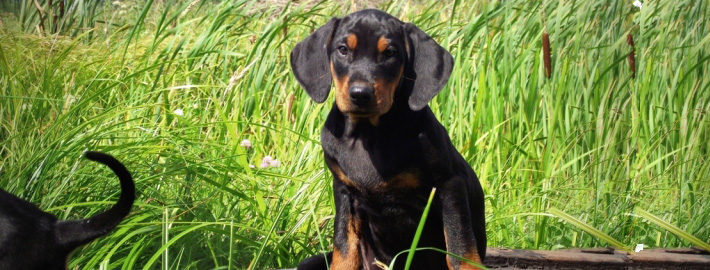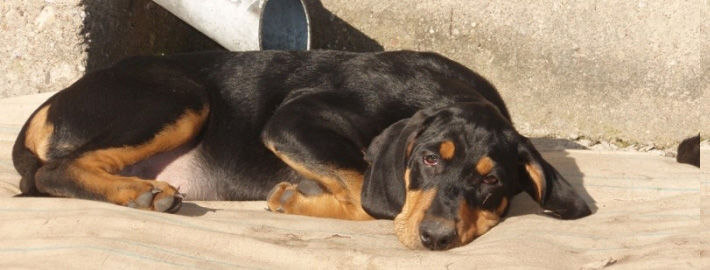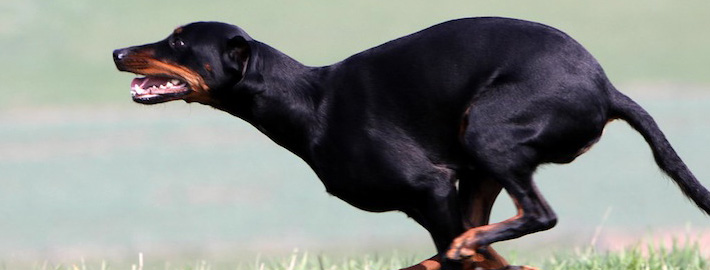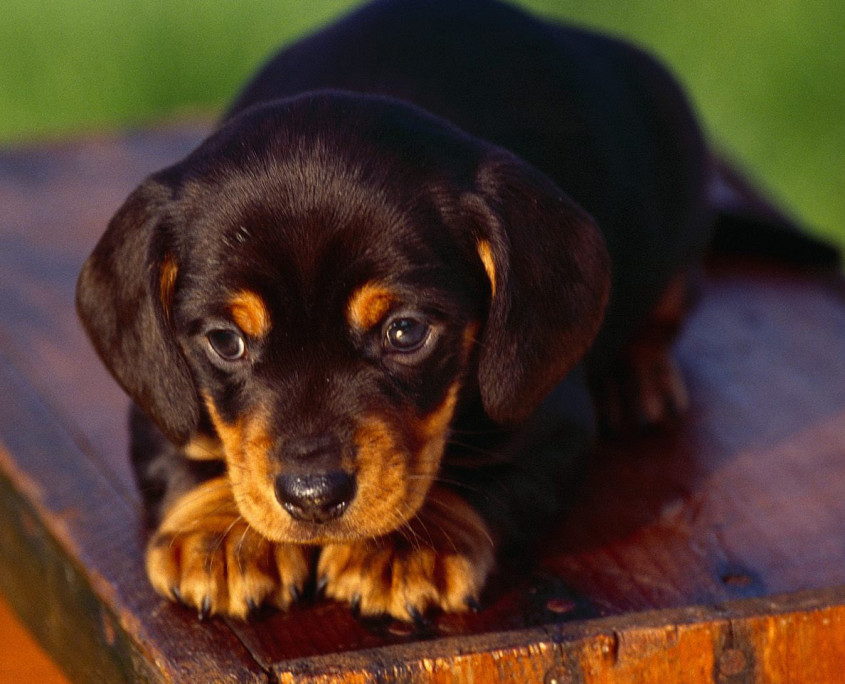What makes the Lithuanian Unique?
The Lithuanian Hound is a result of a careful breeding program conducted by the Lithuanian hunters in the XX century. This breed is highly prized for its superb hunting abilities in its native country but remains rather obscure outside its borders. With proper socialization it can become a faithful and cheerful family pet.
Breed Groups
Page Contents
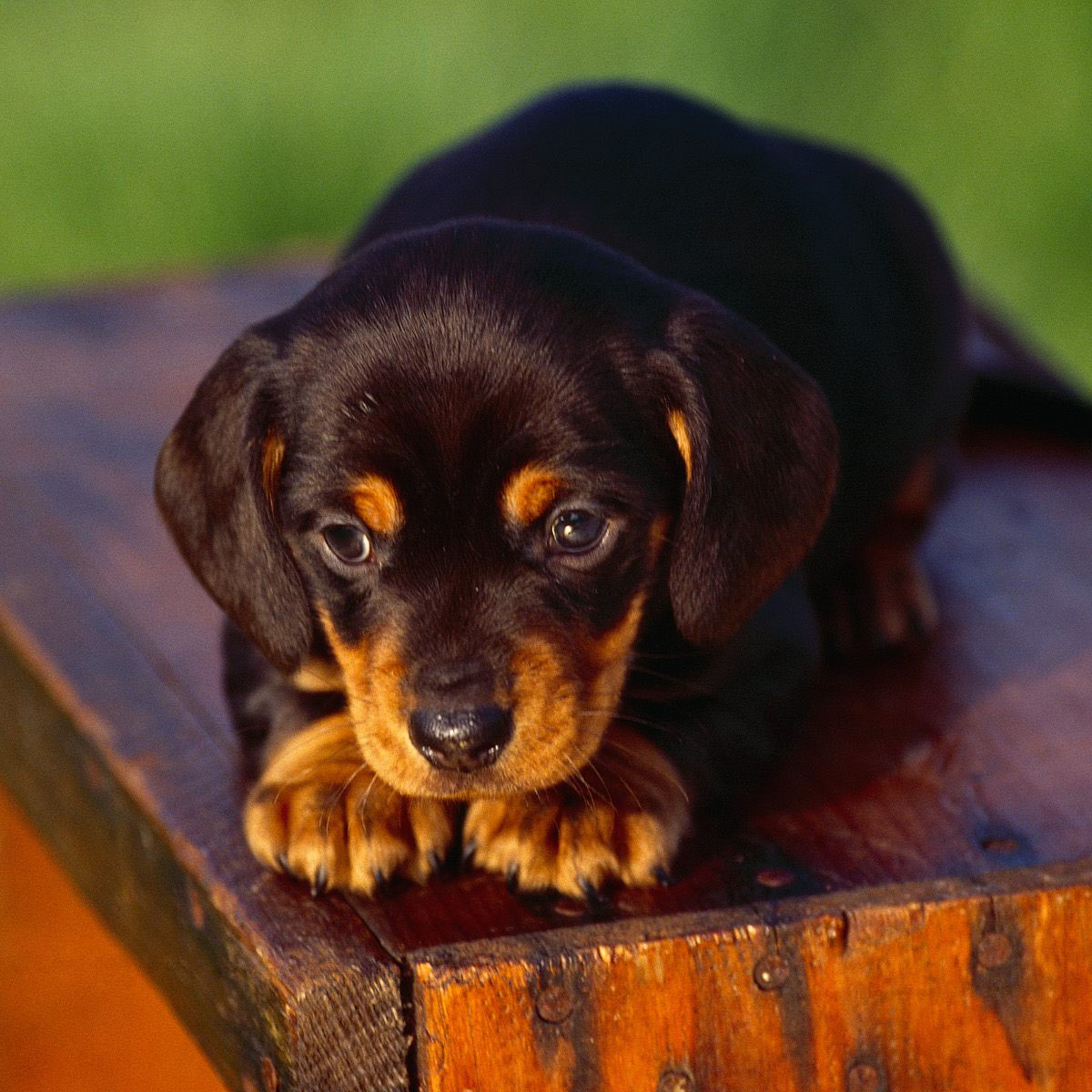
Is the Lithuanian Hound Right For You?
The Lithuanian hound has been traditionally used to hunt hare, fox, and boar. It has a very obiedient, pleasant nature, though it is suspicious of strangers. It requires good running exercise daily. As a hunting dog, the Lithuanian will do best in a large yard where it can get a lot of exercise, and will need to be taken for frequent walks.
In 5 Words
- Alert
- Energetic
- Tenacious
- Responsive
- Intelligent
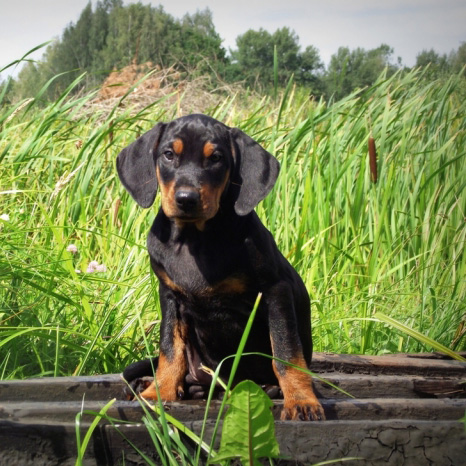
Characteristics
Learn About the Lithuanian Hound
Description
General Description
The Lithuanian Hound is sturdy, heavily boned, muscular and sleek, with a short, glossy black coat and limited tan markings. The tail is long and held low. This hound has less heavy bone than many other hounds his size. However he is still a good sized, robust dog; sleek but with muscular proportions. The head is moderately large and broad between ears. The eyes are brown and medium sized. The ears are moderate length with rounded tips and hang close to cheeks. The muzzle is medium sized and well-proportioned to the head. The nose is black and self-colored according to the coat. It has a scissor or level bite. The neck is moderately long, very strong with no dewlap. The topline is level and the chest is long, deep and broad. The body is medium sized. The legs and forelegs are perpendicular. The thighs are muscular and the hocks are straight and strong. The feet are strong and round, with compact toes. The tail is long, gradually tapering. This breed has a good reach, with a well-balanced movement.
Short History of the Lithuanian Hound
Lithuanian forests, then and now are teeming with wild animals so that hunting with dogs has always been a popular sport. Deer, wild bear, elks beaver, wolves, foxes and a variety of birds make is possible for a hunting enthusiast to indulge in his favorite pastime all year round although the busiest hunting month in this country starts from November to January. The Lithuanian Hound is one of the hunting dogs highly valued for their excellent hunting abilities.
Dogs have been the companion of man for millions of years. Dogs have been utilized in a lot of ways… one of these is hunting. A hunter uses different types of dogs. A hunter would make use of a gun dog to identify the location of the animal being hunted. After the shot, a retriever will be used to recover the quarry. A hound on the other hand is a dog type that that is utilized by a hunter to track the quarry. Once the track of the animal being hunted is found, a hound will begin the chase. A breed of dog is highly valued by Lithuanian hunters for its beautiful voice and impressive eyesight that proven to be most valuable assets in hunting wild boars and other game. This breed is the Lithuanian Hound.
A Lithuanian Hound is a rare breed. This excellent hunting dog is relatively unknown outside its country of origin. Not much is known how this breed developed as very few written documents about the breed’s origin exist although several varieties of hounds were mentioned in the 16th century Statutes of Lithuania. Lithuanian dogs are believed to have existed at the end of the ice age. The Lithuanian Hound though, a breed that came from Russia is considered to be the newest among the Russian scenthounds. A preference for hunting with hounds was adapted by the Lithuanian hunters from the French nobles they have hunted with during the 16th century. Lithuanian hunters utilized their local hounds for big game hunting. In an attempt to recreate the Curlandish Hound, these hunters crossed their hounds with Bloodhounds, Beagles, Polish Hounds and Russian Hounds. The Lithuanian Hound was born. The Lithuanian Hound has several breeds of SSoutstanding hounds for its ancestors thus it would not be surprising for the breed to manifest the excellent hunting abilities of its forebears. This breed is highly valued by Lithuanian hunters. The dog is considered to be as valuable as gold. The breed became very popular in Lithuania but after the Second World War, the breed is already close to extinction.
Efforts to restore the breed were started in 1957. In 1966, a provisional breed standard was made for the Lithuanian Hound. Restoration efforts had a major setback when a lot of dogs were killed by boars during the 1976-77 hunting season. A special kennel devoted to raising Lithuanian Hounds was created by the Lithuanian Cynological Council. In 1981, the first exhibition for the breed was organized. The exhibition was attended by 62 dogs. The Lithuanian Hound is a hardy hunter. This breed is an integral part of Lithuania’s history. Efforts to have the breed recognized by FCI are underway.
Temperament
The Lithuanian Hound was bred exclusively for hunting purpose so it’s usually persistent and relentless in performing its hunting responsibilities. The dog is praised for its good adaptability and it will make a wonderful companion dog. Despite its somewhat independent character it tends to develop a close attachment to its master and his family. The well-socialised dog will also show proper attitude towards children though it may be too big for a toddler.
The Lithuanian Hound is usually calm and reserved in communication with unfamiliar people but some specimen can become a bit aggressive if a strange person intends to pet it. The dog is apt to be highly alert and possesses an excellent nose so it will quickly detect a peculiar sound or smell and forewarn about it its owner. That’s way it will constitute a reasonable watchdog, trusty and attentive.
As a hunting dog the Lithuanian Hound has developed good sociable skills, which help it to get along with other canine animals. It hasn’t been noticed in manifestation of any form of aggressive behaviour therefore it will gladly share its life with one or more other dogs. On the other hand even if this dog and a home cat have been living together since the early age there is no guarantee of their unproblematic coexistence in maturity. As thoroughgoing hunter the Lithuanian Hound is going to chase everything that even slightly resembles a prey and it should never go unleashed unless it’s not in a safely enclosed territory.
Caring for Your Lithuanian Hound
General Health
The Lithuanian Hound is a hardy and sturdy breed. Unlike other working dogs, this breed has a less heavily boned body although it has a sleek and muscular build. This hound measures from 21 to 24 inches at the withers and weighs from 60 to 75 pounds. The Lithuanian Hound has a large wedge shaped head with a broad forehead and a medium sized muzzle that is slightly shorter than the forehead but well proportionate to the size of the head. Medium in size, the oval shaped eyes are brown to dark brown in color. A Lithuanian Hound’s eyes have a vibrant and fresh expression. The wide large nose is black. Medium length triangular shaped ears with rounded tips hang close to the cheeks.
The neck that is slightly shorter than the head is very muscular and tightly fitted with skin creating no dewlaps. The dog has a level topline, a long, deep and broad chest with well developed ribs. Front and hind legs are straight. Thighs are muscular. Strong round feet have compact toes with strong black nails. Well developed pads are black in color. Sword shaped tail is thick at the base. Tail is raised above the backline when the dog is excited and lowered to the level of the hocks when the dog is relaxed. The tail is densely covered with hair. Dense and glossy hair grows from 3 to 5 cm on the back and longer on the neck and tail. Hair that covers the ears and tail are shorter. A Lithuanian Hound is a black coated breed. Some specimens may have brown colored hair in the forehead, ears, snout and chest. A small white spot may also be found on the chest.
Care
Daily
A Lithuanian Hound is a short haired breed thus it would need very little grooming. The naturally glossy coat would not need extensive grooming as occasional brushing will be sufficient to maintain its good condition. An owner must thoroughly check the dog for ticks, fleas and other parasites after it is hunted. This breed is not recommended for apartment living. This is a highly energetic dog. It would need at least a small yard where it can use up its excess energies. The dog should also be taken for long walks as well. A Lithuanian Hound would make an ideal jogging or hiking
Grooming & Bathing
The coat of the Lithuanian Hound demands insignificant amount of attendance to keep it in a fairly good condition. Its hair possesses natural gloss and several brushing a week will be sufficient to maintain its essential softness and smoothness. The dog should also pass through a thorough investigation after a hunt in order to spot ticks or other parasites in its coat. This breed requires a bath only occasionally preferably once in two months.
Exercise & Training
The Lithuanian Hound is fairly easy to train due to its obedient and stable demeanor. This clever animal craves nothing more than to make its owner happy so with your proper commitment you will be able to impress your acquaintances with advanced tricks, which your dog will perform easily and gracefully.
The owner of the Lithuanian Hound should put in considerable amount of time to maintain it in a good form and happy. You should take your dog for an hour brisk walk each and every day. This dog will gladly accompany you in jogging or cycling and will tirelessly run beside you for endless hours.

